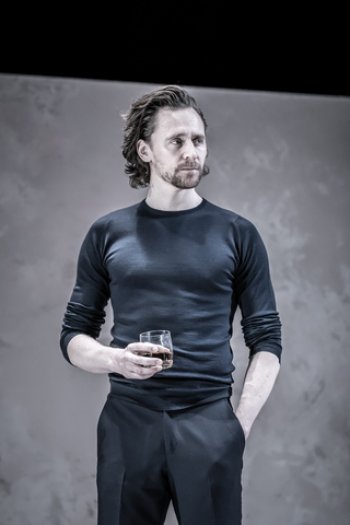Betrayal
British star of stage and screen Tom Hiddleston as Robert far surpasses his most famous reputation as Loki in both "Thor" and "The Avengers," giving a nuanced and ever-changing performance.

Zawe Ashton, Charlie Cox and Tom Hiddleston in a scene from Harold Pinter’s “Betrayal” in revival at the Bernard B. Jacobs Theatre (Photo credit: Marc Brenner)
[avatar user=”David Kaufman” size=”96″ align=”left” ] David Kaufman, Critic[/avatar]
Given the enormous shadows that are frequently cast on the walls of the Bernard Jacobs Theater, the current Broadway revival of Harold Pinter’s brilliant play Betrayal seems to have six, as opposed to just three characters. It’s fitting for a play of such complexity, in which the three players keep redefining themselves and each other as they move backwards in time. (The inspired lighting design is by Jon Clark.)
Imported from London and directed with finesse by Jamie Lloyd, Tom Hiddleston (Robert), Zawe Ashton (Emma), and Charlie Cox (Jerry), all making their Broadway debuts, are practically choreographed as they move about on an otherwise spare if elegant stage that features two simple chairs, a small table and little else. (The startling scenery and apt costumes have been designed by Soutra Gilmour.) That, too, is an appropriate metaphor for three characters that keep shifting their positions.
And keep your eye on the revolving stage: if Betrayal is a play which moves backwards in time (from 1977 to 1968) as Robert, Emma and Jerry recall their intimate relations–even as two of them are cheating on the third, at various points–the stage too, sometimes, rotates backwards, while a second rotating stage moves in the opposite direction. This adds a great deal to the ingenuity of Lloyd’s staging.

Tom Hiddleston in a scene from Harold Pinter’s “Betrayal” in revival at the Bernard B. Jacobs Theatre (Photo credit: Marc Brenner)
If any number of critics felt over the years that the backward chronology was just a gimmick of Pinter’s, it actually is a beautiful conceit that adds to the play’s intricacies. While a relatively recent version featured Daniel Craig and Rachel Weisz, there was also an outstanding film version staring Jeremy Irons, Ben Kingsley, and Patricia Hodge in 1983, or less than a decade after the original production premiered at London’s National Theatre in 1978.
What may have been a relatively straightforward story of love, and yes, betrayal, achieves so much more via the way it’s told. While Emma runs an art gallery and her husband Robert is a publisher, Jerry, a literary agent, was the best man at their wedding, and ergo, presumably Robert’s best friend. This makes Jerry’s commencing an affair with Emma seemingly the biggest betrayal of all. But given the order with which the scenes unfold, “commencing” can be a misleading word.
According to Robert, Jerry is “talented at uncovering talent.” A case in point is an ostensibly brilliant author named Casey, who’s represented by Jerry and published by Robert. If Casey’s name keeps coming up, it should–he’s even been “seeing” Emma on the side–which means she’s betraying not only Robert but also her paramour Jerry. Still, perhaps the biggest betrayal of all is that, as we learn, Robert knows his best friend has been sleeping with his wife–without letting either of them know that he knows–call it a betrayal by default.

Charlie Cox, Zawe Ashton and Tom Hiddleston in a scene from Harold Pinter’s “Betrayal” in revival at the Bernard B. Jacobs Theatre (Photo credit: Marc Brenner)
And while part of Pinter’s point is that we all have difficulty remembering certain things, this is possibly best eluded to by recurring references to the time when Jerry tossed Emma and Robert’s young daughter up into the air, though they can’t recall whose kitchen the special, fondly recalled moment occurred in. Lloyd had the uncanny idea to add the scene itself as a coda to the play–and in a coup I don’t recall from any other production, Lloyd has even added a young girl for realizing the event.
Hiddleston as Robert far surpasses his most famous reputation as Loki in both Thor and The Avengers, giving a nuanced and ever-changing performance, and Cox as Jerry also finds subtleties that elude most actors, as their characters undergo constant changes. But it’s Ashton, in her breakout performance here as Emma, who proves most surprising, even as she establishes herself as an actress who will be reckoned with. Her Emma vacillates at any given moment, between certainty and un-, love and bewilderment. She, along with her two co-stars, makes the production a must-see.
Gilmour has wisely put Robert and Jerry in dark clothes with dark jackets, while Ashton is clad in just a powder-blue top and a pair of jeans–not to mention bare feet. (This last would seem to make her more vulnerable than the two male characters, wearing shoes, of course.) If this production was reportedly sold-out for its London run, it takes nothing more than ninety minutes, invested in seeing it, to see why.
Betrayal (through December 8, 2019)
The Jamie Lloyd Company production
Bernard B. Jacobs Theatre, 245 West 45th Street, in Manhattan
For tickets, call 212-239-6200 or visit http://www.betrayalonbroadway.com
Running time: 90 minutes without an intermission






Can anyone explain how the lighting is done, to produce sharply outlined shadows against a uniformly lit rectangle? A single point light source would give uneven illumination, while multiple light sources (or a source that’s distributed in space) would give multiple overlapping shadows (not sharply outlined).